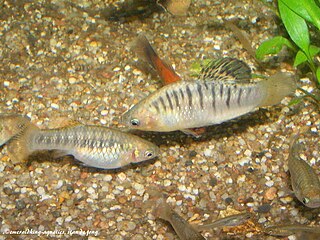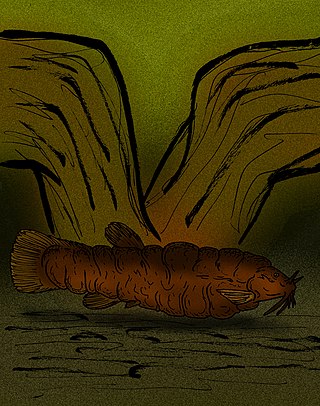
Poecilia is a genus of fishes in the family Poeciliidae of the order Cyprinodontiformes. These livebearers are native to fresh, brackish and salt water in the Americas, and some species in the genus are euryhaline. A few have adapted to living in waters that contain high levels of toxic hydrogen sulfide and a population of P. mexicana lives in caves.

Limia is a genus of livebearing fishes belonging to the Cyprinodontiform family Poeciliidae, which includes other livebearers such as platys, swordtails, guppies and mollies. They are found in fresh and brackish water. Of the 21 described Limia species, 17 are endemic to Hispaniola, one is found on both Hispaniola and Jamaica, and the Cayman Islands, Cuba, and Venezuela have an endemic species each. Limia are popular in aquaria among more advanced hobbyists.

Amaranthus brownii was an annual herb in the family Amaranthaceae. The plant was found only on the small island of Nihoa in the Northwestern Hawaiian Islands, growing on rocky outcrops at altitudes of 120–215 m (394–705 ft). It was one of nine species of Amaranthus in the Hawaiian Islands, as well as the only endemic Hawaiian species of the genus. It is now considered extinct.

The humpbacked limia or black-barred limia is a critically endangered species of poeciliid fish which is endemic to Haiti. Its common name is derived from the hump males develop as they age. It is sometimes kept in home aquaria.

Limia perugiae, or Perugia's limia, is a poeciliid fish endemic to the Caribbean island of Hispaniola. It is one of the most widespread species in the Limia genus, inhabiting waters ranging from fresh to hypersaline.

Rhizosomichthys totae is a species of catfish of the family Trichomycteridae, and the only species of the genus Rhizosomichthys. This fish grew to about 13.8 centimetres (5.4 in) and was endemic to Colombia where it occurred in the Lake Tota basin. It is listed as a critically endangered species by the IUCN Red List. The species was last seen in 1957, and only 10 specimens were found. The disappearance is possibly linked to the release of 100,000 imported rainbow trout eggs into Lake Tota in 1936.
The spiny giant frog or Norton's robber frog is a species of frog in the family Eleutherodactylidae. It is named after James W. Norton who accompanied Albert Schwartz in his 1974 expedition to Hispaniola and collected the holotype.

The yellow-blotched map turtle, or yellow-blotched sawback, is a species of turtle in the family Emydidae. It is part of the narrow-headed group of map turtles, and is endemic to the southern United States.
The whitefin swellshark is a species of catshark, belonging to the family Scyliorhinidae, endemic to southeastern Australia. It is found 126–554 m (413–1,818 ft) down, on the outer continental shelf and upper continental slope. Reaching 1.1 m (3.6 ft) in length, this shark has a very thick body and a short, broad, flattened head with a large mouth. It is characterized by a dorsal color pattern of dark saddles and blotches over a brown to gray background, and light fin margins. When threatened the whitefin swellshark can inflate itself with water or air to increase its size. Reproduction is oviparous. As of 2019 The International Union for Conservation of Nature (IUCN) has assessed this species as Critically Endangered due to the significant decline of the population.

The pindu is a critically endangered species of cichlid endemic to Lake Barombi Mbo in western Cameroon.

The Otjikoto tilapia is a critically endangered species of cichlid fish endemic to Namibia where it was originally only found in Lake Guinas. This very small sinkhole lake contains quite clear water that generally ranges between 18–25 °C (64–77 °F) depending on season, and the Otjikoto tilapia has been seen down to depths of 67 m (220 ft). Despite deriving its common name from the nearby Lake Otjikoto, it in not native to that lake, rather being an introduced species. It is rare in the aquarium trade and also kept in garden ponds in southern Africa.

Platythelphusa is a genus of freshwater crabs endemic to Lake Tanganyika. It has been placed in a number of families, including a monotypic family, Platythelphusidae, as well as Potamidae and its current position in the Potamonautidae, and has also been treated as a subgenus of Potamonautes. It forms a monophyletic group, possibly nested within the genus Potamonautes, which would therefore be paraphyletic. The genus is the only evolutionary radiation of crabs to have occurred in a freshwater lake, and it occurred recently, probably since the Pliocene. This parallels the better known radiation of cichlid fishes in Lake Tanganyika. Only one other species of freshwater crab is found in Lake Tanganyika, Potamonautes platynotus.
Limia melanonotata, the blackbanded limia, is a toothcarp in the family Poeciliidae. It is endemic to the island of Hispaniola.
Shreve's least gecko, also known commonly as the northwest Haiti blotched sphaero and the northwest Haitian blotched geckolet, is an endangered species of lizard in the family Sphaerodactylidae. The species is endemic to Haiti.

Limia sulphurophila, also known as sulphur limia, is a livebearing fish in the family Poeciliidae. It is endemic to the Dominican Republic in the island of Hispaniola.

Limia islai, also known as the tiger limia, is a species of fish within the family Poeciliidae. This species is one of several Limia that are endemic to Lake Miragoâne, Haiti.
Phyllomedusa neildi is a species of frog in the family Hylidae endemic to Venezuela. Scientists know this frog solely from its type locality: Sierra de San Luís. This frog has been observed between 550 and 1150 meters above sea level.

Limia melanogaster, the black-bellied or blue limia, is a poeciliid fish from Jamaica. It inhabits fast-flowing streams. It is a rare livebearer in modern fishkeeping.

Limia tridens, commonly known as the Tiburon limia, is a poeciliid fish endemic to the Caribbean island of Hispaniola.
Limia grossidens, also called the largetooth limia, is a critically endangered poeciliid fish endemic to Haiti.













